
surfresearch.com.au
sally field : gidget, 1965.
sally field : gidget, 1965.
|
|
|
|
|
|
 |
surfresearch.com.au
sally field : gidget, 1965. |
| Page 144 (Following a termination) Six weeks later , in early November, three days before my eighteenth birthday, I began my career. Wearing a dreadful swimsuit, I stood on a cold Malibu beach, looked directly into the camera, and said my first line of dialogue. "You see before you, me. Gidget." Page 121 Part Two
Approximately eight weeks and a handful of surfing lessons later, production began and I walked through the looking glass. On one side was my life, my real life as it existed, and on the other side was a greatly altered world. And my God, how I loved the girl on that side of the glass, loved her ease around people, her trust in them. She was pure and untarnished. My twin sister, who looked very much like me, was a part of me, and yet was not me. For thirty-two episodes- and many more weeks than that- her house, her friends, her family, and her perfect pink-and-yellow bedroom were mine. |
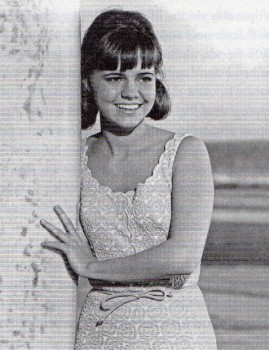 |
| I knew next week I
would have a crush on a handsome schoolteacher, or
be thrust into auto shop at school, showing a group
of adorable boys that I was as good as they were,
while being appealingly inept. Or I'd be caught in a misunderstanding with my family- her family, not mine. Page 123 From the barely dawn morning, when I'd drive onto the Columbia lot, until long after the sun had set, I lived in Gidget's world. Then I'd climb back into my newly purchased yellow MGB, carefully work the frighteningly unfamiliar stick shift, and drive back through the looking glass into Sally's world- where my feet hurt so bad I thought of putting them in a pan of hot water and Epsom salts, the way Aunt Gladys always did. Page 127 |
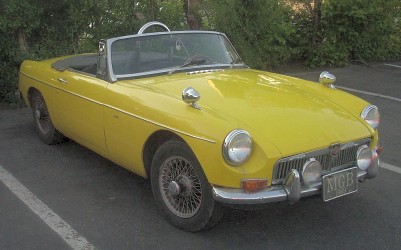 |
| Page 128 running off camera where everyone would pile up out of view of the lens, desperately trying to keep from stepping into the water, which seriously did not smell right. The reverse shots, the ones revealing where we were running- toward the ocean- were filmed during the few days when we actually went to one of the beaches in San Monica or Malibu where I'd spent so much of my life. Or those days- as few as they might have been- I'd vibrate with the same excitement I felt when I was a kid, knowing we were going to spend the day frolicking in the ocean. But the ocean I'd always known in the Augusts of my childhood was very different from the one I met that November day when we first filmed on the beach. It was freezing, both the water and the air. Everyone was wearing gloves, ski hats, and heavy down jackets. Everyone except for me, that is, and of course the handful of surfers- real surfers- who clustered around totally unfazed by the weather, the cold water, or the waves. While I clung to the large terry-cloth robe that had been placed over my shoulders, most of the true surfers were so eager to jump in the water that they'd barely registered theirs, abandoning them immediately. White terry-cloth piles ended up scattered around the sand. I can't say the swell was especially big-three to five feet- but to me the waves looked huge. Adding insult to injury, this was not a "point break" like the easy rolling waves of Mondos Beach above Oxnard, where I'd been taken many times by Darryl, the surfing coach. This was a "beach break," and Zuma, for God's sake. Notoriously difficult to ride. While I stood there shivering, hoping they'd decide to shoot something else, the assistant director held up his bullhorn and |
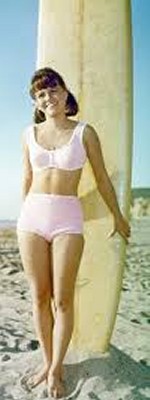 |
| I didn't even have
a car before I began to work, and the huge board,
which weighed more than I did, was the same size as
my new MGB, so how would I have gotten the thing to
the beach? Just in case someone on earth had missed his last message, the assistant director blasted another "IN THE WATER!" So off went the robe and into the icy water went the girl. Since it supposed to look like a sunny summer day, no one wore wet suits of any kind, and the water was so cold the lower half of my body instantly went numb. There I was in the water, sitting on a board the size of the PT-109, trying to power a stiff blue body that barely knew how to maneuver this craft under the best of circumstances. I mean, really, what the hell were they thinking? Were they just testing to see if I was serious about this whole acting thing? Then again, was this acting or a study in humiliation? Or is acting always walking on the edge, always flirting with the possibility of falling flat on your face, or of wiping out and losing the top of your bathing suit? I know that the latter option was going through my head when I heard the faint but unmistakable bullhorn voice shriek, "TAKE THE NEXT WAVE!" and before I could even look to see if there was indeed a wave to take, I heard the stopping word: "ROLLING!" Even now, as I remember this moment in the cold Pacific so long ago, it's not the sound of the waves I hear, or the Page 130 |
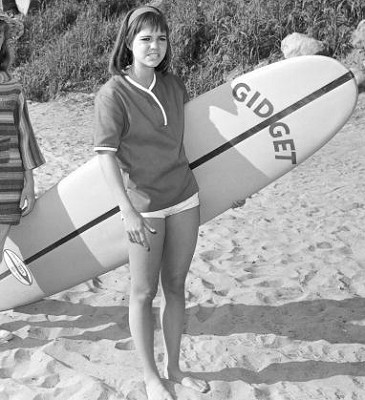 |
Without hesitation, I put my forehead on the board and began paddling furiously, pumping my legs up and down at the same time, trying to inch my big board forward, now aware of the wave forming behind me. Just when I thought I'd failed, had missed the wave and the shot would continue on without me, Mickey Dora, the champion surfer who was by my side, pushed my gigantic board in front of the wave exactly where I needed to be. When I tentatively started to stand, Mickey grabbed my hand as he expertly maneuvered his board beside me. Small though it might have been, we rode the entire wave until finally we slid gently to the shore and the flabbergasted crew began to cheer. I don't know how many more waves I caught, or Mickey tossed me into- it didn't matter. I'd found something new. I was terrified, yes, but instead of letting some other part of myself perform the task while the rest of me floated away, I had held the reins and fearlessly, without thinking, told myself to just go. Mickey Dora expertly manoeuvring his board beside Johnny Fain, Malibu Contest, 1965. |
 |
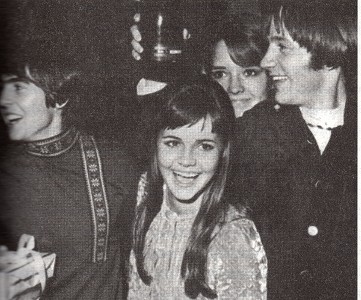 My
twenty-first birthday party, hosted by Screen
Gems.
Davy Jones, Sally Field, Peter Tork. Mike
Nesmith, Davy Jones, Micky Dolenz and Peter
Tork.
(The Monkees) |
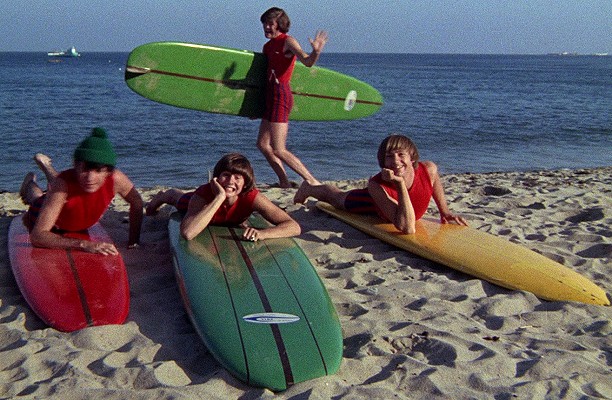 |
| All
MGBs from 1962 to 1967 used a four-speed manual
gearbox with a non-synchromesh, straight-cut first
gear. https://de.wikipedia.org/wiki/MGB_(Auto) PT-109 was the number of a patrol torpedo boat commanded by future US President, John F. Kennedy, in the Pacific in WW II, the movie PT 109 was released in 1963. The role of JFK was played by Cliff Robertson, following his appearance in 1959 as the Big Kahuna in the first Gidget film. https://en.wikipedia.org/wiki/Motor_Torpedo_Boat_PT-109 Mickey Dora, the champion surfer On land, Dora was widely known to be highly critical of competitive surfing; in the water he was known as a highly aggressive competitor, at least by Johnny Fain. However, despite competing in numerous events it appears that there is no record of Dora actually winning a contest. Also see Mickey Dora |
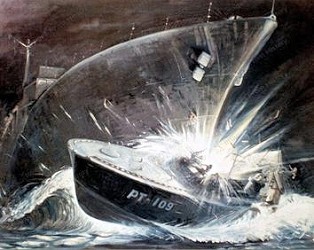 |
|
Episode 7: 1x07 - Gidget is a
Proper Noun
Gidget is
convinced that her English teacher expects more
of her than his other students because she is
the daughter of his former English professor,
Russell Lawrence.
https://www.dailymotion.com/video/x1i5n8u Episode 6 Sally Field - Gidget: A Hearse, A Hearse, My Kingdom For a Hearse (October 20, 1965), clip 1 https://www.youtube.com/watch?v=wFU9lM9uEvk Episode 13: 1x13 - The War
Between Men, Women and Gidget
An isolated beach cove becomes
the object of a battle between the boys,
Gidget and the girls.
Episode 25:
1x25 - Love and the Single Gidget
While Russ is out of town, Gidget attends a surfing tournament in Oceanside with Anne and John’s blessing—unaware that they have hired a college student to look after her. Unfortunately, there is no footage of surfing at Oceanside. https://www.dailymotion.com/video/x1i97as The New Gidget Season 1- Theme, 1988 https://www.youtube.com/watch?v=2BR7sTjRQDU Field, Sally:
In Pieces - a memoir, Simon and Schuster, London, New
York, 2018.
|
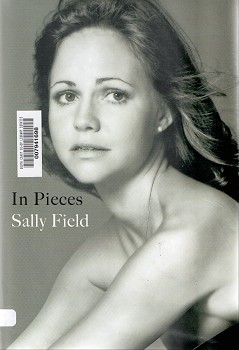 |
| The Real
Gidget Kathy Kohner, 1956. Sandra
Dee and Kathy Kohner, 1959.
|
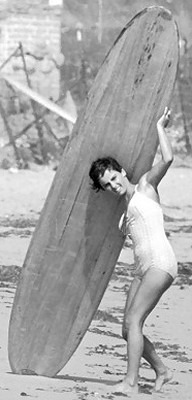 |
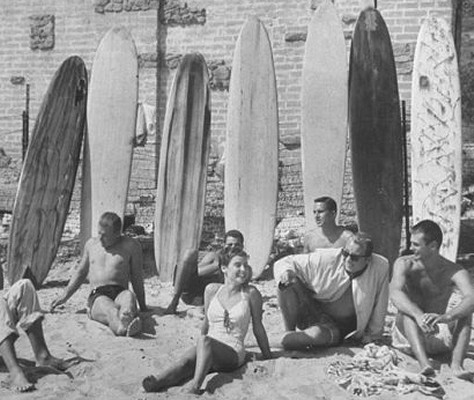 |
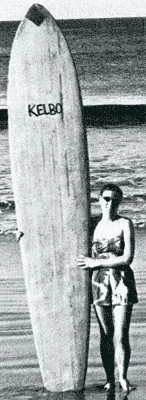 |
|
Kohner, Frederick:
https://archive.org/details/gidget00kohnGidget-
The Little Girl with Big Ideas
G.P. Putnam's Sons, New York (1957) Hard cover, b&w illustrations, Jacket by Ben Feder, Inc., Jacket photo by Ernest Lenart. Review Made into a classic film in 1959; starring Sandra Dee (Gidget), James Darren (Moondoggie), and Cliff Robertson (The Big Kahuna). Review by Nick Carroll Gidget- I wrote a little bit about this in support of my theory that in the area of fictional and/or literary endeavour, surfing usually only gives rise to cheese. This is great cheese, appalling, epic cheese, and has undoubtedly represented the surfing milieu to a greater number of (oh dear) baby-boomers than any other surfing related cultural expression, including Endless Summer. Gidget is massively and rightly ignored on the score of influence within the surfing hard core, but so what? (Tim Winton's) Breath is probably the best piece of fiction anyone will ever write about surfing, but it'll never overtake Gidget in the public recognition stakes. - realsurf forum, Sunday Sep 19, 2010. http://forum.realsurf.com/forum/search.php?t=18006 Comet: Kathy Kohner Zuckerman Interview https://cometoverhollywood.com/2015/09/02/it-was-my-fathers-success-an-interview-with-the-real-gidget/ |
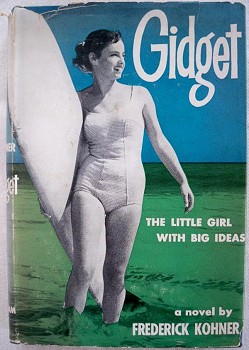 |
 Gidget, 1957. |
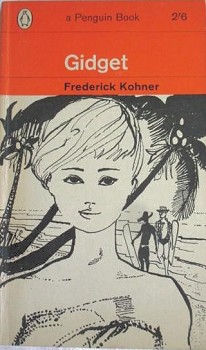 Gidget, 1963. |
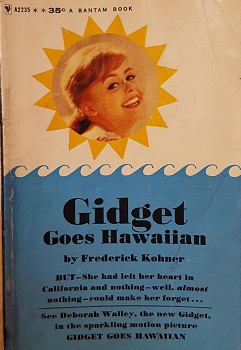 Gidget Goes Hawaiian, 1963. |
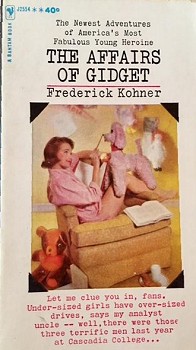 The Affairs of Gidget, 1963. |
 Gidget, 2001.
|
| Gidget
From the novel by Fredrick Kohner, Gidget, the Little Girl with Big Ideas, and based on his own daughter, Kathy. The first of a string of Hollywood surf movies, directed by Paul Wendkos and starring Sandra Dee, James Darren and Cliff Robertson. Surfing by the Malibu crew including Mickey Dora (as Moondogie) and Mickey Munoz, reported as doubling as Gidget in a blond wig. However, note that in the surfing footage below, Gidget is a goofy-footer. Gidget - (Original Trailer) http://www.tcm.com/mediaroom/video/115882/Gidget-Original-Trailer-.html Gidget (1959) A learning-to-surf sequence http://www.tcm.com/mediaroom/video/307192/Gidget-Movie-Clip-Getting-Straignt-A-s.html Gidget (1959) - (Movie Clip) Before You Melt: Surfing Footage http://www.tcm.com/mediaroom/video/307193/Gidget-Movie-Clip-Before-You-Melt.html Also see: https://en.wikipedia.org/wiki/Gidget_(film) IMBd:
Gidget (1959) Photo Gallery
https://www.imdb.com/title/tt0052847/mediaindex?ref_=tt_mv_closeGidget Goes Hawaiian (1961) Tribute https://www.youtube.com/watch?v=-c3GutOMhXI |
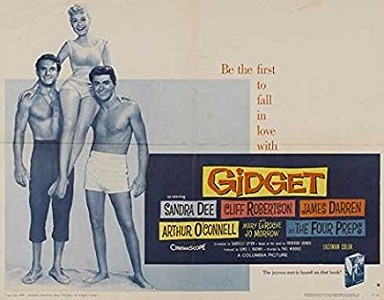 |
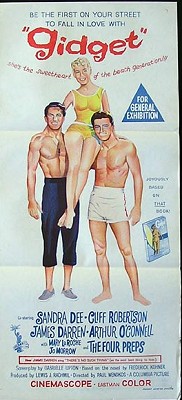 |
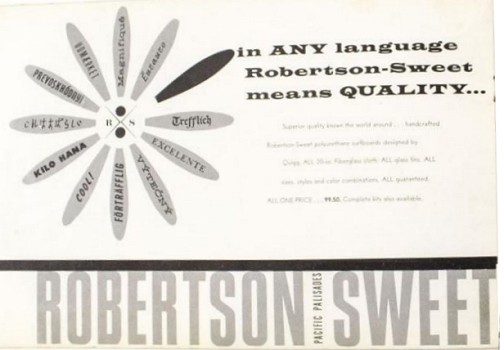 Quality in ANY language - first edition of Surfer magazine, 1960. |
Robertson-Sweet
... 4 Solid products
Skin-diving magazine ?, 1962? (For or Four Solid Prducts?) Made in one sold piece of polyurethane rigid foam under 100,000 pounds pressure. Lighter - Stronger - Unsinkable A complete range of dive and surf equipment including spear-guns, wetsuits surfboards and paddle-boards. The Scubaboard, bottom, apparently has a see-though underwater window inserted through the board. The sailboard (?) with centre-board and fin is only an illustration. |
 |

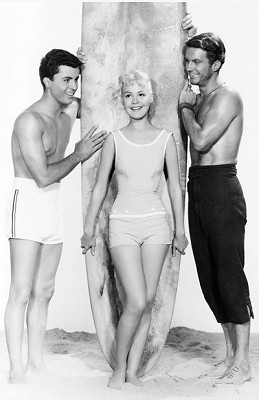 |
How
not to carry a surfboard ...
Sandra Dee. James Darren, Sandra Dee and Cliff Robertson. |
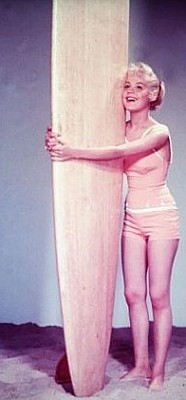 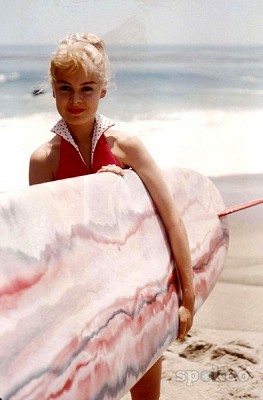 |
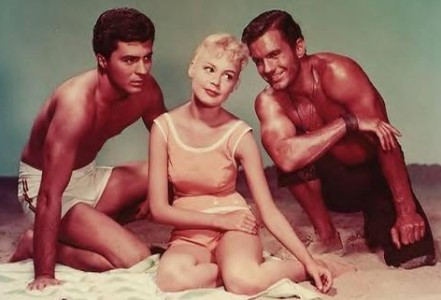 James Darren, Sandra Dee and Cliff Robertson. |
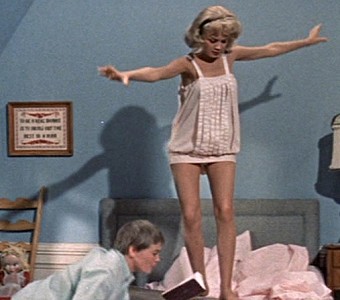 Gidget's bedroom surfing lesson, from a book. |
 Moondoggie and Gidget tandem, back projection. |
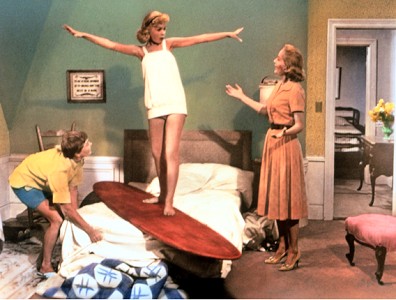 Gidget's bedroom
surfing
lesson.
Vogue, 1959. |
Rose Marie Ried Juniors
Vogue, 1959 Sandra Dee and James Darren |
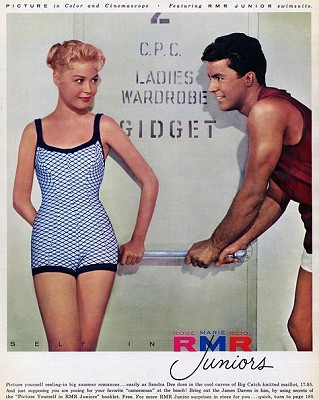 |
 Kathy
|
 Kathy
|
 Sandra |
 Sandra
|
 Sally |
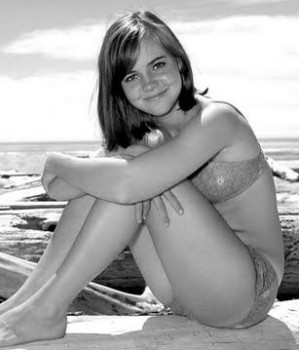 Sally |
 Sally |
|
|
da Cat/Moondoggie
|
|
|
|
|
|
|